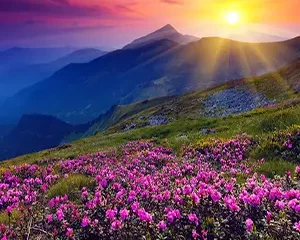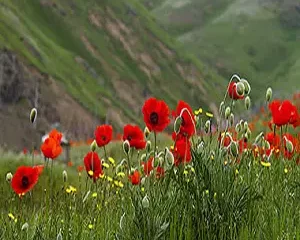Nigella flower specifications
- Scientific name : Nigella sativa L
- Order : Ranunculales
- Family : Ranunculaceae
- Genus : Nigella
- French name : Nielle du Levant, Toute épice, Cuminnoir, Nigelle des jardins
- German name : Echter Schwarz, Schwarzer coriander, Echter Schwarzkümmel
- Italian names : Gittaione, Nigella, Melanzio domestico, Erba spezie
- Other name : Love in a mist, Miss Jekyll, Jack in the green, Devil in the Bush, Jack in Prison, Love Entangle, Bride in hair, Love in a Puzzle, Love in a Snarl
- Native : Eastern Europe
Nigella flower is a plant of the genus nigella, covered with fine hairs or completely hairless. Its leaves are divided into narrow, thread-like parts. The nigella flowers are solitary and the leaflets below are large flowers that are milky in color with a greenish or bluish side. Its seeds are dark in color, triangular and have a special smell.
This plant has white and purple flowers with fern-shaped leaves consisting of leaflets, which surround the flower in such a way that an aura can be seen around it. The flowers are white, blue and pink and there is a pod around it.
read more : Everything about bangardia flower : How to Plant & care for them

Nigella flower
The height of nigella flower reaches 38 to 50 cm. nigella flowers are planted in combination with other annual flowers in the margins and this flower is used to decorate the margins. The color of these pods changes with the age of the plant, so that at first they are milky in color. They turn green and then red.
Nigella is sometimes wild flower and sometimes agricultural. Nigella is an annual herbaceous plant. Wild nigella is also an annual herbaceous plant, very short and its leaves are similar to cultivated nigella, with narrow divisions.
The best time to plant this plant is late spring or early summer. Warm and humid climate is one of the needs of this plant for growing in an apartment space. The room temperature should be set so that it does not be more 25 degrees Celsius and the minimum temperature that nigella can tolerate is 10 degrees Celsius.
read more : Everything about scabiosa flower : How to Plant & care for them
Iran dried nigella flower
One of the most important medicinal plants is nigella, which is grown in Iran as a wild flower and can even be cultivated. This plant species has been the basis for the production of various medicines in the world, which is used in combination with other medicinal compounds.
Nigella flowers have pods that enhance the beauty of the flower. This flower is very suitable for making bouquets. To prepare a bouquet, it is enough to put a few different branches of this flower together and then you will have a very beautiful bouquet.
Nigella plant is one of the export goods of Iran and has provided a great opportunity for Iranian traders to bring a lot of currency to the country by exporting dried nigella flowers . Both types of nigella products can be exported either as medicinal plants or as dried flowers ( can be used in interior decoration ) because each has its own customer. The export of dried nigella flower has provided a great opportunity for wholesalers and exporters of dried nigella flower and other medicinal plants to make significant profits.
read more : Drying natural flowers | Introducing 8 wonderful ways to dry flowers

Dried nigella flower
Place of growth of nigella plant
Nigella is grown in various parts of southern Europe, Eastern Europe, Bulgaria, Cyprus, Romania and West Asia, as well as Iran, Turkey and Iraq. This plant grows in Arak and Isfahan and different parts of Iran.
Flowering time of nigella plant
The flowering time of nigella is the end of May to July.
The way of planting and propagate nigella plant
The best time to sow nigella flower is early spring. The best way to plant this plant is through seeds. Pots should be filled with soil rich in sand, gravel and organic fertilizers, and seeds should be planted at a depth of 25 cm.
Sprinkle some soil in a pot or basket and sprinkle the seeds on the soil and pour about half an inch on the soil and then water well. About 5 to 15 days later the seeds turn green and when they reach 8 cm they are removed from the treasury. This is the best method in the place where you want to plant at a distance of 20 or 30 centimeters.
read more : Everything about hemlock flower : How to Plant & care for them
Some people sow the seeds in the place they want to grow there, but this method is not correct because the seeds fall irregularly on the ground when sowing, and when they grow, many of them may grow together. But when you plant the seeds in the greenhouse, then you can regularly plant the plants of this flower in any way and at any distance you want.
Nigella should be planted in a well-drained soil, the place chosen for sowing should be a sunny place. Nigella grows in most soils but grows better in rich and fertile soils. nigella flower do not need to be covered.
It is also recommended to plant nigella flowers in a row. This flower needs a short time to flower. When the flower dries, the seed pod is striated ( in nigella damascena type ). This flower is used fresh or dried to make a bouquet and is a good flower to make a dried bouquet.
The plant flowers one year after planting in the spring, regular watering and changing the potting soil is involved in flowering and preventing the growth of nigella flowers. Propagation of this plant in summer is possible through seeds and cuttings.
read more : Everything about vaccaria flower : How to Plant & care for them
Care of nigella flowers
Caring for nigella is very easy. Irrigation during drought should be done, for better growth should be regularly given nutrients to the soil. To encourage growth, it is best to separate the wilted flowers from the plant and collect the seeds from the dried pods.
-
watering
Nigella water requirement is moderate. The best time to water is when it should be done regularly and at least twice a week. Before watering the plant, it is better that the soil surface is dry. If the soil is wet and the soil water is high, the plant will be damaged, increasing the risk of pests
-
Soil
This plant grows well in a variety of soils and only needs proper soil drainage. The most suitable soil pH for growing nigella is six to seven and a half. Acidic soils help the plant to strengthen and grow faster.
The plant flowers one year after planting in the spring, regular watering and changing the potting soil is involved in flowering and preventing the growth of nigella flowers. Propagation of this plant in summer is possible through seeds and cuttings.
-
Light and temperature
This plant needs full sun and of course in warm areas it is better to be in the shade in the afternoon. It is also highly compatible in terms of temperature.
read more : Everything about lagurus plant : How to Plant & care for them
Types of nigella flower
Several N. damascena cultivars have been developed for gardens throughout temperate areas. Common cultivars include :
- Miss Jekyll : a popular and common variety with flowers in shades of white, blue, and rose
- Miss Jekyll Alba : a double, white-flowered cultivar with bright green seed pods
- Persian Jewels : a mixture of purple, pink, lavender, blue, rose, and white shades that grows 12 to 18 inches tall
- Blue Midget : a dwarf variety that grows to only about ten inches tall; suitable for edging
- Cambridge Blue : a long-stemmed variety with double blue flowers and best for cutting
Other cultivars worth looking into include ‘Mulberry Rose’, ‘Oxford Blue’, and ‘Albion’.
Notice : This article translated by google form Persian language. If you have any question or need more information please contact us or add a comment at the bottom of this page.


0 Comments